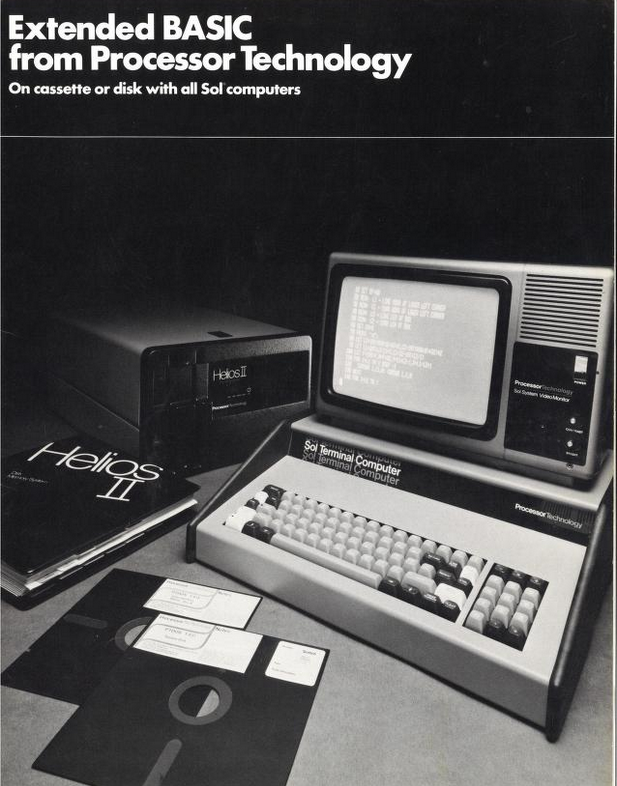
We are now reaching our last episode on Processor Technology’s SOL-20 (see the first one here). While the SOL-20 had the privilege of being the first computer designed (among others) for gaming, there was no video game industry to speak of at its release in 1977. Processor Technology understood the importance of providing software in addition to hardware, but its offer was meagre. Here is the exhaustive list (as far as I know) of games on their catalogue :
- Gamepac1, a compilation of Target, Zing (a “Pong” clone), a game of Life and Pattern, a simple kaleidoscope but without, you know, the colours, so not very kalos.
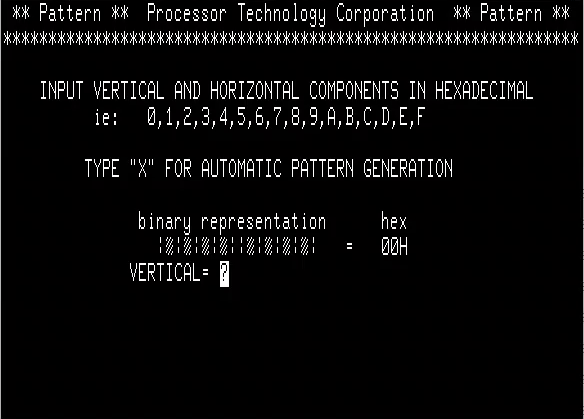
- Gamepac2, a compilation of Qubic (a 4x4x4 Tic-Tac-Toe) and Hangman
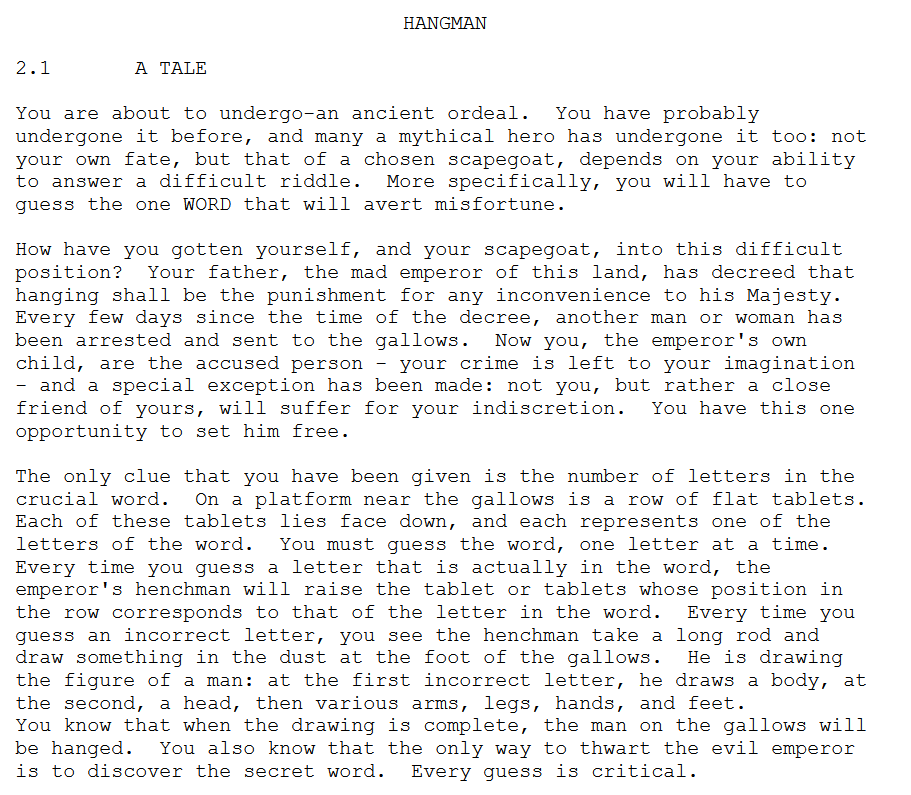
- Finally, you could buy Trek80 or a game of Chess as stand-alone. That’s it.
If you were not satisfied with this offer, you would have to turn to books and magazines. Long printouts of code you could retype (“listings“) were all the rage, and the offer was plentiful, though of course the quality was often poor, and if the program was good then it was probably tedious to type. Over time, magazines would offer cassettes, either bundled with the magazine or in direct order, but typically those cassettes would only include games that had already been offered as type-ins, not new games. I browsed through the SOL-20 offering of listings and cassettes and none of these were wargames, except for a few ports of mainframe games we already know.
The last solution, then, was for SOL-20 users to write games themselves and/or exchange them with other users. The SOL-20 archive managed to collect a good number of these games, but the only wargames in the list come from our friend Ralph Hopkins. Alas, I don’t know whether those games were ever distributed (through exchanges or other informal channels), but I found two of them interesting enough that I wanted to cover them as examples of what could be done on a SOL-20.
Seawolf (1979)
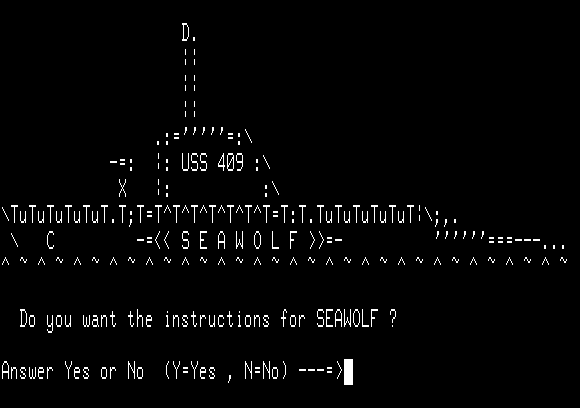
Seawolf is Ralph Hopkins’ attempt to improve upon the earlier Warfish by Randy Witt by adding options and enemy types. The command list, in particular, is expanded from 3 orders (PERISCOPE, TORPEDO and DIVE) to 9 :
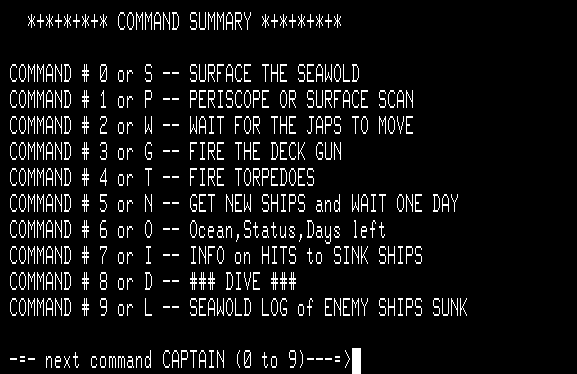
In Seawolf, patrols last 28 days during which I will not be able to resupply my torpedoes and the shells of my gun deck.
The campaign starts with good omens. The first day I encounter a defenceless “fleet supply ship” at 900 yards. I surface and shoot at it with my deck gun. While doing so, I am interrupted twice by the taunts of “Bungo Pete” (from Run Silent, Run Deep), an enemy you actually have a chance to encounter – though I never did in my playthroughs. His taunts are quickly tedious, as they happen every 5 to 10 actions in the game.
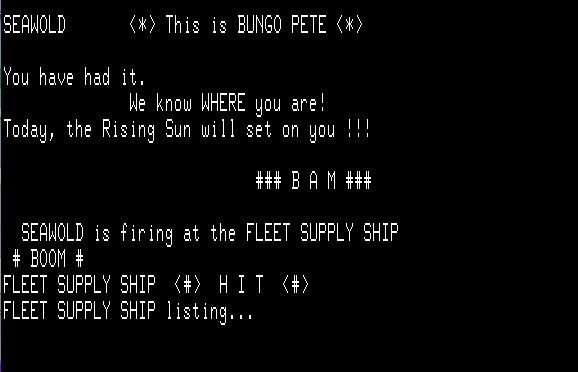
That’s all for the first day. The second day, I encounter a cluster of ships of all sizes :
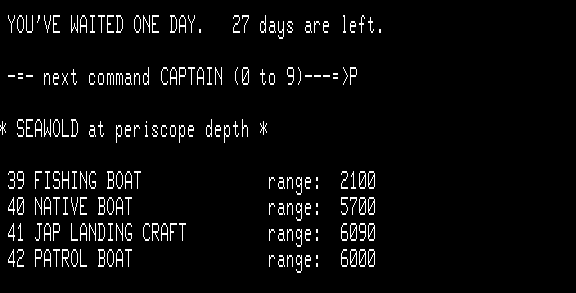
I send two torpedoes toward the patrol boat, sinking her, and then surface to gun down the landing craft. Just as I ponder whether I should also sink the fishing boat and the native boat, a corvette arrives. I crash-dive immediately !
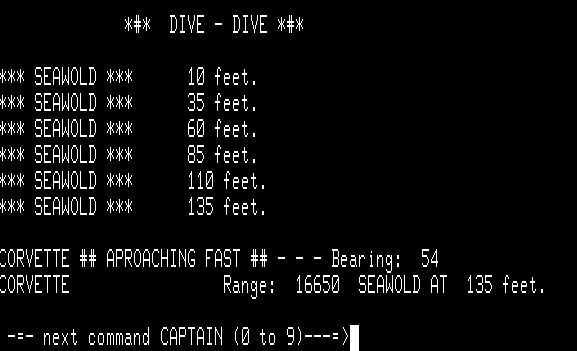
I wait for the corvette to approach (presumably to depth charge me) and sink it with two torpedoes. That’s the end of the day, as I am unwilling to attack harmless wooden ships.
After avoiding a destroyer on day 3, I encounter a particularly juicy group of targets on day 4 :
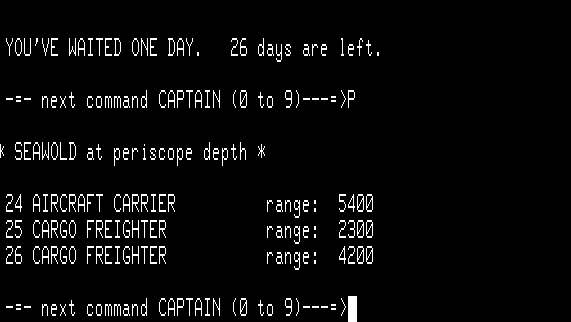
Aircraft carriers in Seawolf are glorified tankers because the game does not feature planes. After a salvo of 6 torpedoes and then another salvo of 4 torpedoes, the Japanese aircraft carrier is sunk. I then surface and destroy the two other ships with my gun, and feel confident about my prospects of receiving the Medal of Honor.
The following days are a rut : I avoid groups of enemy combat ships and sink defenceless cargo ships. I mostly use my deck gun, because I am down to 6 torpedoes after sending too many towards the aircraft carrier. It forces me to take a bit more risk than I would like.
It works, for a time. My demise happens when I engage a fleet supply ship with my deck gun on day 10 :
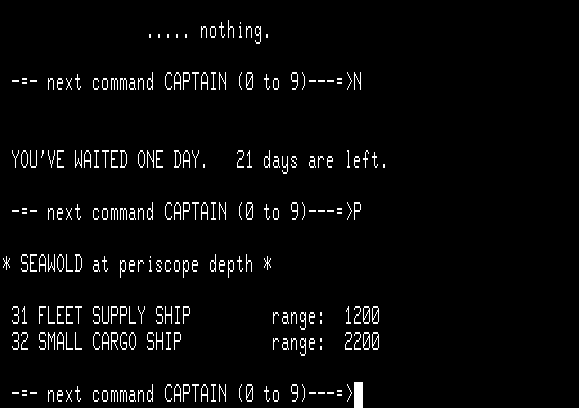
I start by using my deck gun and hit the supply ship badly when a destroyer escort decides to jump into the fray, engaging me with its own gun :
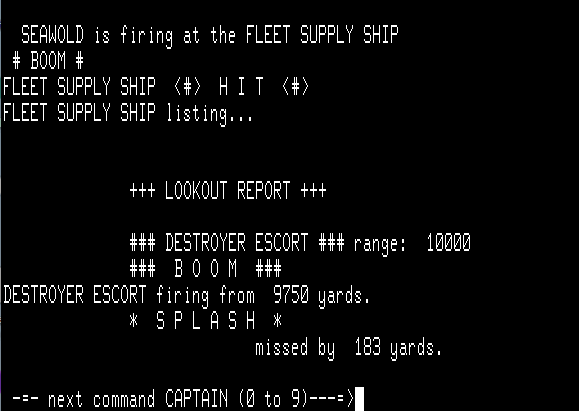
The warship is still far away, it is missing me by quite a lot, and the fleet supply ship is already listing. Certainly I have enough time to finish off the cargo before diving and escaping …
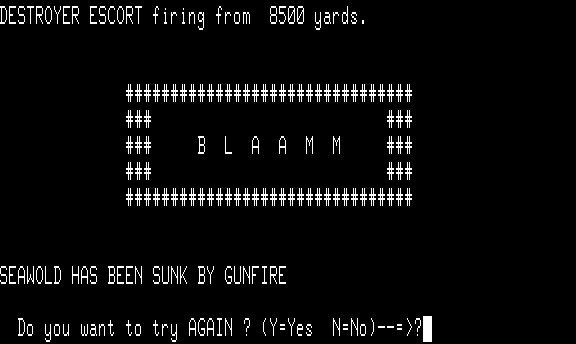
… it turns out I do not.
Seawolf is not a great game, but certainly, it is a massive improvement over Warfish. It was also, I believe, a stepping stone toward Hopkins’ next series of games.
PATTON (1979) and the TANK games
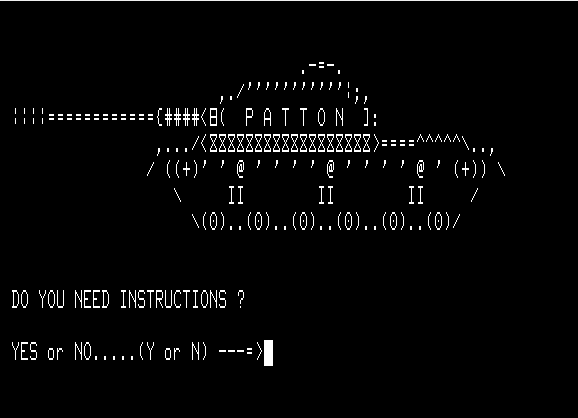
PATTON is part of a series of 4 games (officially “TANKS”, TANKZ”, “KORPS” and “PATTN”) that replace the submarine by armoured vehicles, with each of the 4 games a different combination of countries. The games were most probably developed by Ralph Hopkins between 1979 and 1981 and according to notes added by the author, they were “inspired” by Seawolf.
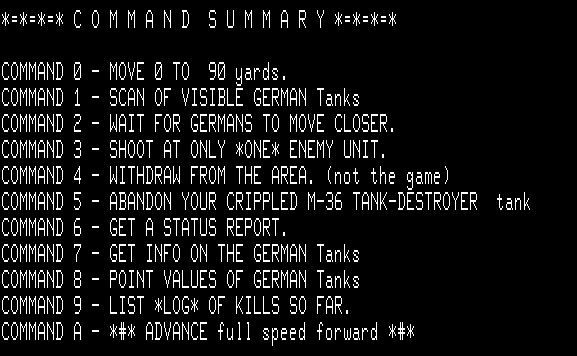
The TANKS games give you a random tank at the beginning of each session, or if you are German and unlucky a static 88mm gun. In PATTON, the worst vehicle you can get is an M5 Stuart, but I am given a M-18 “Hellcat” tank destroyer : fast, powerful and decently armoured. I also start FORTIFIED on a ROCKY SLOPE according to the game.
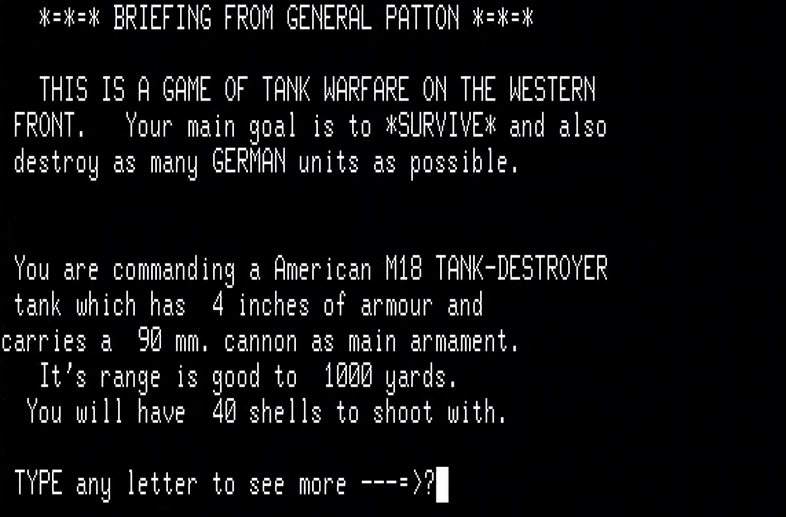
I start the game directly within sight of the Germans : initially a Panzer IV, a Flakpanzer and further in the back a 75mm Howitzer – the latter can’t move and is too far away to shoot at me.
I start shooting at the Flakpanzer, the only one in range to shoot back :
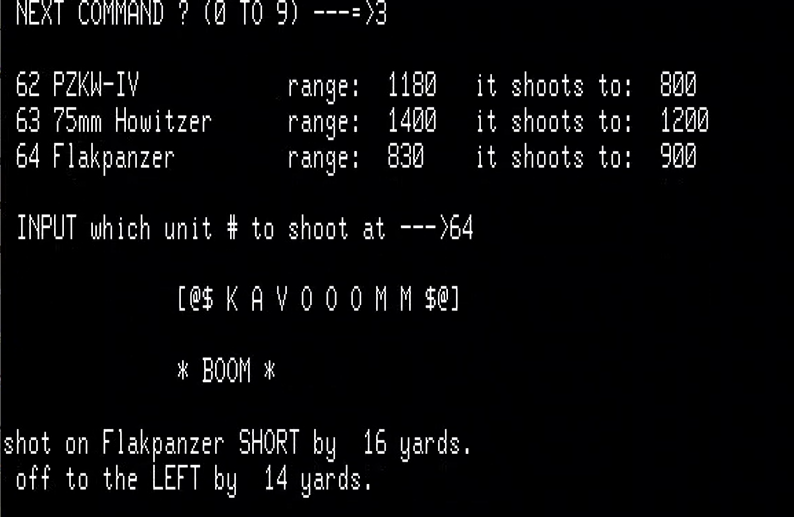
I destroy the tracks of the Flakpanzer, immobilizing it. A good start, but after that, all I manage to do shell after shell is to “stun” repeatedly the Flakpanzer, which stops it from firing for one turn. The few times the Flakpanzer manages to shoot at me it either misses me or “dents” me.
When the Panzer IV arrives in a range where it can shoot at me, I focus my attention on it and immediately immobilize it :
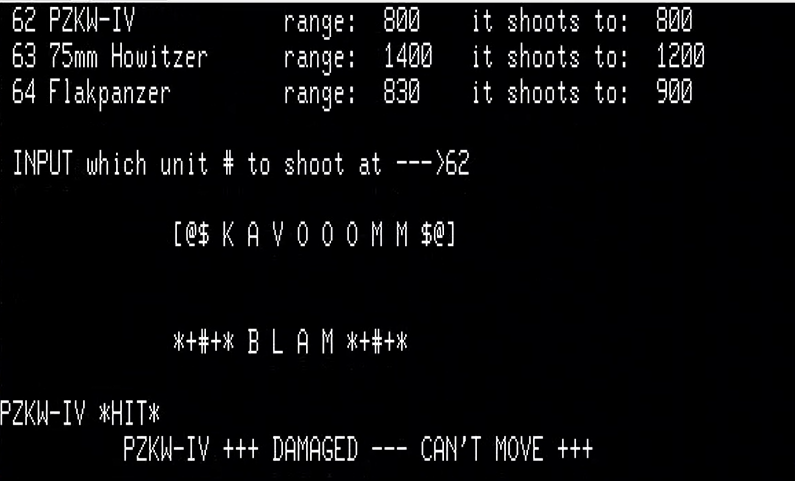
With both enemy armours unable to move, I move back a tiny bit to get out of their range and start shooting them repeatedly. I manage to destroy the Panzer IV, but the Flakpanzer is seemingly impervious to my weapon.
Eventually, I am frustrated and advance at close range. The Flakpanzer shoots at me but I brush off its shells, and I shoot it at 670 yards, destroying it.
My elation is short-lived : TIGER !
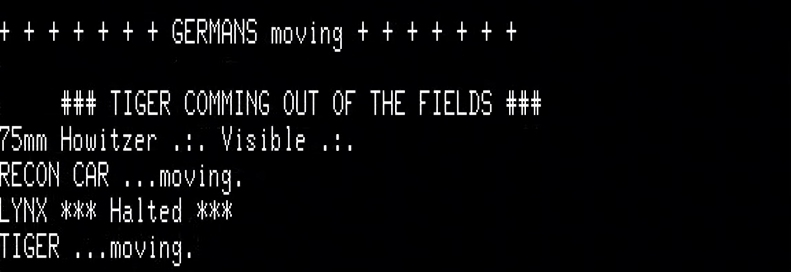
Given I was not able to pierce the armour of a Flakpanzer, I doubt I am going to do anything to a Tiger tank, and I use my superior speed to withdraw :
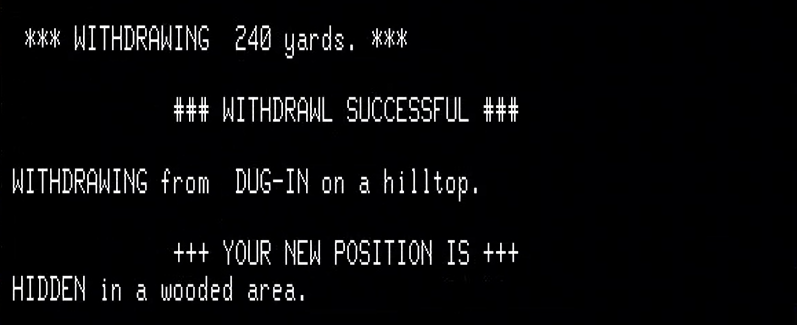
After waiting for a tiny bit, a new opponent arrives : a Panther Tank.

I am apparently hidden so I assume the Panther can’t see me. I let it approach but I lose my nerve at 800 yards and start shooting – much too early to pierce its armour. The Panther shoots back :

Uh ! No retreat possible now, though I could still abandon my vehicle. But I am not deterred, and I don’t want to give a victory to the SS! I shoot again and again, “stunning” the Panther 7 times in a row. But the 8th shell only “dents” it, and the Panther can shoot back :
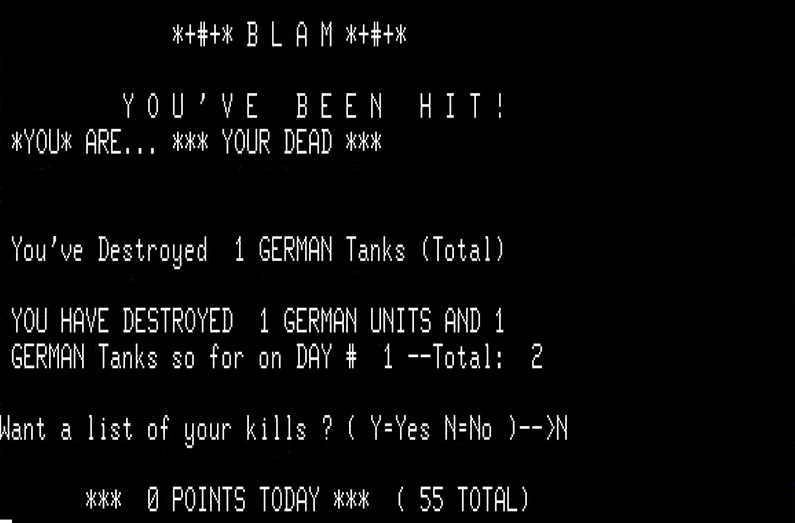
That’s the end of my career in the US Army – I had much longer and more successful careers in my earlier playthroughs.
The TANKS series is surprisingly fun to play, even today. It reminds me of the indie game Armoured Commander (available on Steam), but easier to play and trimmed down to the essential. There is a lot of luck involved – target prioritisation always seemed obvious to me so most of my real decisions were about whether to fight or to retreat. Still, it has this strong “just one more attempt” ; I had planned to play the game one hour before writing my article but before I knew it I had been at it for 4 hours, and I don’t regret anything !
The other Ralph Hopkins wargames
Ralph Hopkins designed at least 4 other wargames : all based on Mayfield’s Star Trek “engine” (for lack of a better word). Three of them are fully functional, but they are tedious. I don’t really want to play more Star Trek or Star Trek-adjacent games, and as those were never officially released I do not have to either according to the rules I set for myself. Those games are :
- Luftwaffe (1977), a game where the player controls a wing of P-47s escorting bombers across occupied Europe. It is the most playable of the lot, but I never managed to find the bombers so I ended up attacking the ground target directly with the P-47s.
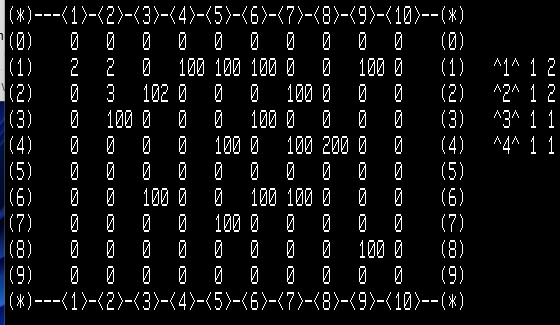
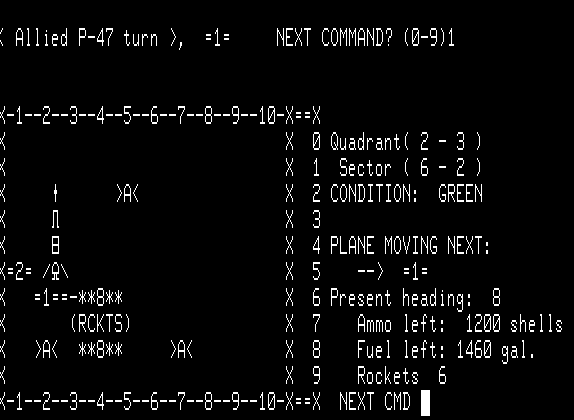
- Midway (1979) where the player is now fighting for the Allies in the Pacific. It is slow, complex (you need to manage 3 ships, 27 planes of 5 different types and Midway itself) and fully undocumented. I never found the Japanese fleet – not that I tried a lot.
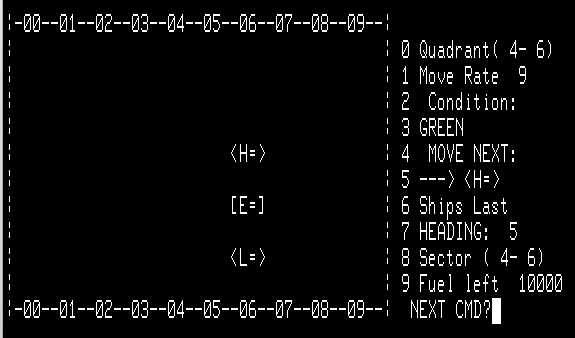
- Combat (1982), a game that Hopkins considered “the Ultimate Star Trek” game. It has 8 Federation Starships, and that’s 7 more than I am willing to play at the same time.
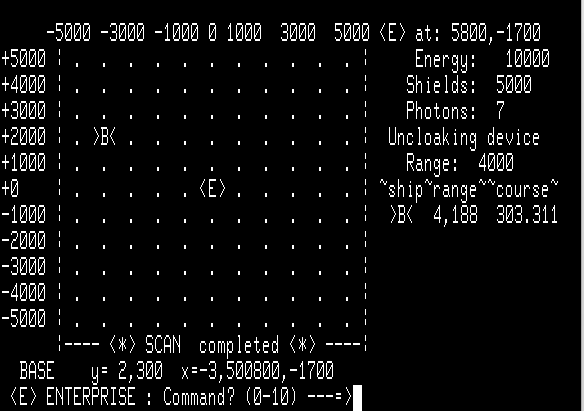
Finally, Galactica is an unfinished Battlestar Galactica game that I could not even launch – it was started in 1978 and the last update according to the code was in 1981.
The end of Processor Technology
This is where we bid goodbye to the SOL-20 and those who created it. When we left “Proc Tech” in our previous article, it was an up-and-coming company, well on its way to selling 10 000 VDM-1 and 12 000 SOL-20 computers. Alas, Bob Marsh and Gary Ingram were unable to transition from start-uppers to market leaders. Lacking business experience, awash with cash-flow, they lost sight of what allowed them to prevail over MITS : their capacity to deliver cheap and reliable products.
It started with the disk system. Cassettes were unreliable, and everyone in 1977 understood they would be replaced by floppy disks sooner or later. Processor Technology contracted a company called Diablo to provide them with the disk system, but Diablo failed to honour its contract after being bought by Xerox. Processor Technology then provided its own solution called Helios (based on the tech of another company called PerSci), but it was extremely expensive ($1700) and capricious. Just as MITS had been undercut by Processor Technology, Processor Technology found itself undercut by providers, in particular North Star and its $600 floppy disk drivers.
This kept happening. Processor Technology insisted on using a proprietary OS called PT-DOS, but it was snubbed because the market was moving toward the CP/M [Control Program/Monitor] standard. Processor Technology tried to compensate for the increasing obsolescence of the 8800 chip it was using (compared to the Z80 chip) by providing 32K and 64K memory boards, but as another echo to what happened to MITS these proved totally unreliable. An attempt to add colour to the SOL-20 led nowhere. Processor Technology had lost its touch, possibly because it had moved to Pleasanton, some 30 miles from San Francisco, from its hobbyists and, decisively, from Lee Felsenstein and his incredible technical skill.
Meanwhile, the Trinity of 1977 arrived on the market, and at $1400 (with VDM-1) the SOL-20 had stopped being competitive :
- TRS-80 was what it was, but it released at half the price of the SOL-20 ($600 including the video monitor),
- Soon after that the Apple II which was only marginally cheaper than the SOL-20 ($1300) but had colour and graphics,
- Finally, the Commodore PET was sold at $795 and came for the first time with a lowercase font.
The SOL-20 could not compete on price, it could not compete on specs, and it could not compete on the commercial aspect either : the TRS-80 had the nationwide network of Radio Shack, Apple II had the partnership of the MECC (“a computer in every classroom”) and Commodore had, well, Jack Tramiel. Processor Technology also squandered a last opportunity to stay in the market : Apple, Tandy and Commodore had order books so full they would take up to two years to clear it, but with no new computer launched after the SOL-20 there was no way for Processor Technology to bridge this gap. Marsh and Ingram had followed the market perfectly when they had created modules for the Altair 8800, but now they had been unable to anticipate it.
In May 1979, Processor Technology closed its doors. Ingram left the computer industry, Lee Felsenstein and Bob Marsh would both independently join Osborne. [edited after Lee Felsenstein’s comment] Lee Felsenstein will join Osborne to design the first “portable” computer : the Osborne-1 and Bob Marsh carried on producing computer add-on, including a RAMdisk upgrade for the Osborne.
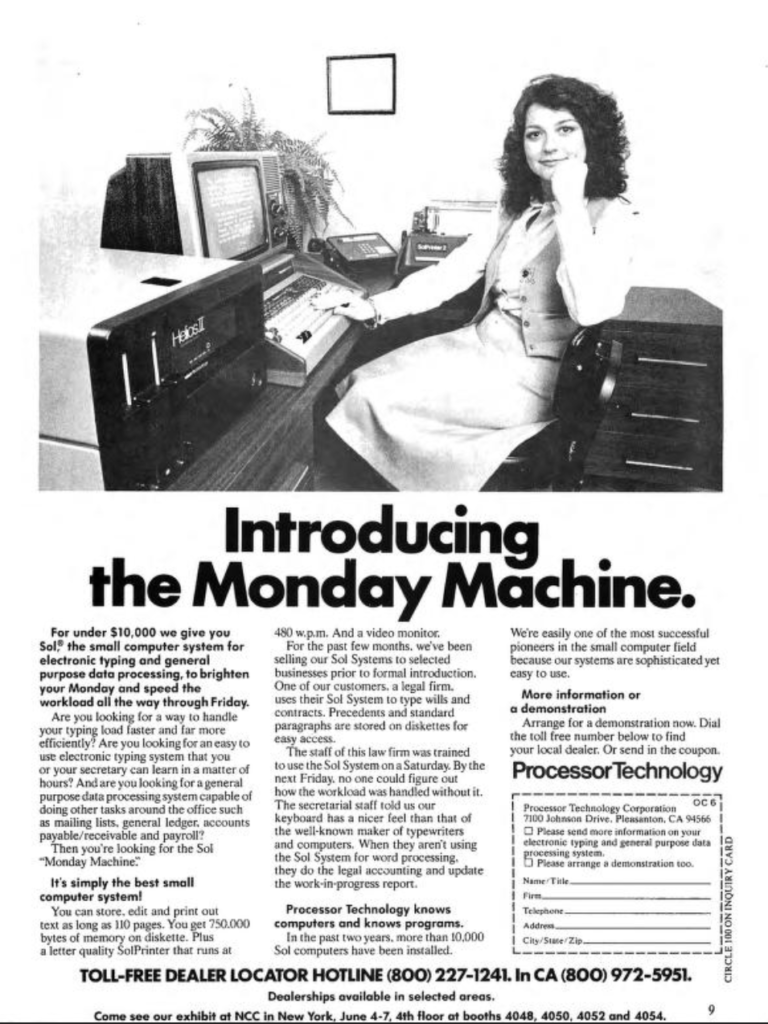
Lee Felsenstein learned it when he could not find their booth at the convention mentioned at the bottom.
For our next article, we will come back to 1983 and our normal line-up of games, and if you are sad I did not play Hopkins’ Midway then you will be happy to know I am now playing the Battle of Midway in Gary Grigsby’s Carrier Force, in addition to other games with more colour on the screen ! If before that you want more DIY games for the SOL-20 that are not wargames, the RPG Explorador has covered the RPG Deathmaze (in Spanish) while Renga in Blue has covered the adventure game Skull Cave.